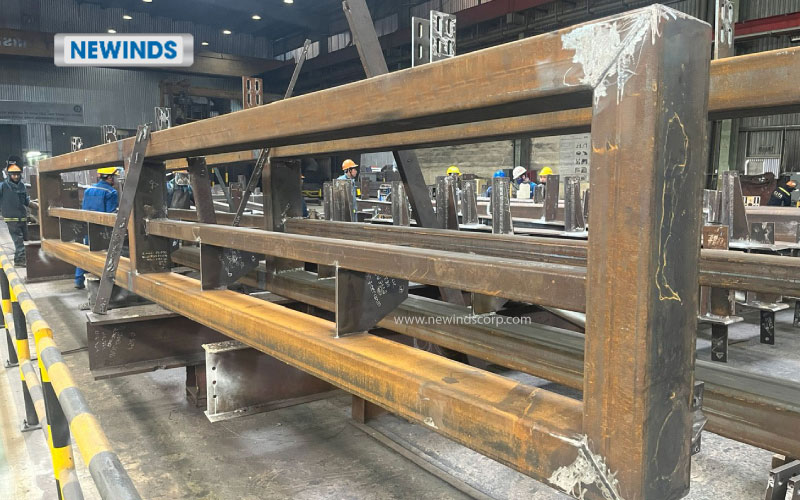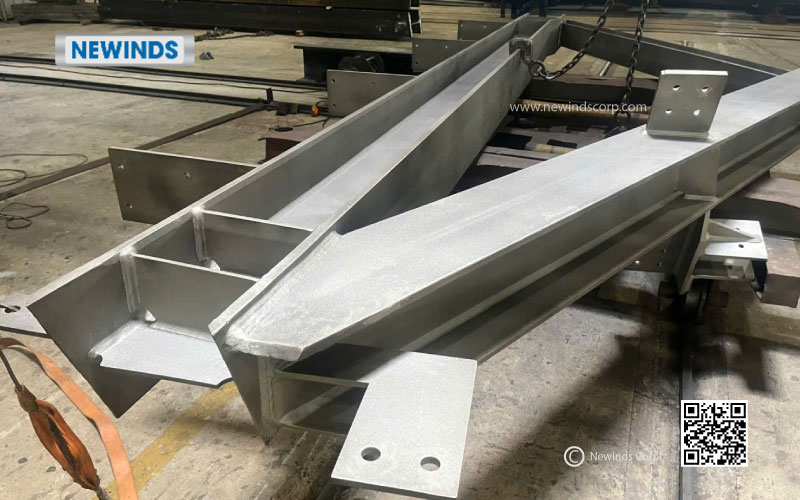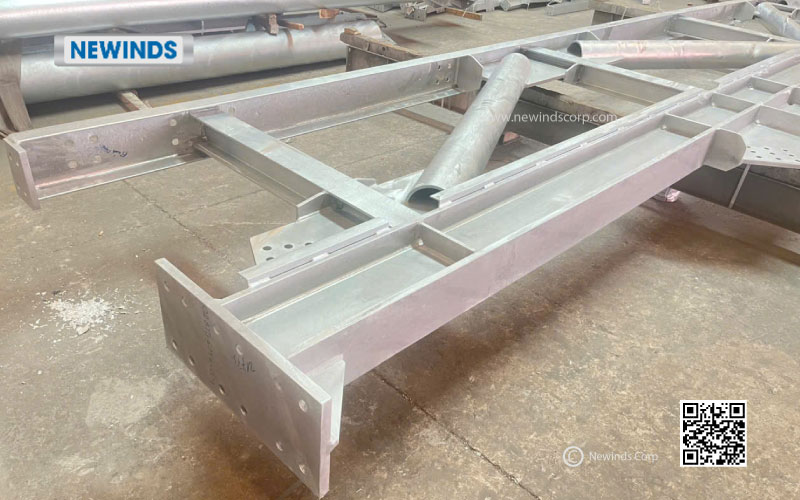To ensure long-term quality, durability, and safety, compliance with steel structure standards is essential in the design, fabrication, and erection of steel structure projects. The following article will help you understand the key standards you need to know, as well as how to choose a reliable steel structure manufacturer.
WHAT IS STEEL STRUCTURE?
A steel structure is a load-bearing system consisting of steel components such as beams, columns, trusses, and girders. These elements offer high strength, durability, and flexibility, making steel structures easy to assemble and highly efficient. Steel structures are widely used in commercial buildings, factories, bridges, and large-scale infrastructure due to their ability to withstand heavy loads, harsh environments, and time.
WHAT ARE STEEL STRUCTURE STANDARDS?
Steel structure standards are a collection of technical documents, guidelines, and specifications covering every stage of design, fabrication, erection, and quality inspection. These standards ensure that the structure meets strict safety and durability requirements across various conditions and regions, including structural systems like steel frame structures and steel roof trusses, which are vital for modern architecture and industrial construction.
Currently, commonly referenced standards include:
-
AISC – American Institute of Steel Construction
AISC 360: Specification for Structural Steel Buildings
This is the foundational code for structural steel design in the United States. It outlines the principles for load calculations, structural integrity, and connection methods. AISC 360 allows engineers to design using two major methodologies:
- Allowable Strength of Design (ASD)
- Load and Resistance Factor Design (LRFD)
Its widespread acceptance extends beyond the U.S. to countries in Asia, the Middle East, Africa, Central America, and Oceania.
-
ASTM – American Society for Testing and Materials
- ASTM A36
A basic carbon steel used in frames, beams, floors, and pre-engineered steel buildings. It features a minimum yield strength of 250 MPa (36 ksi) and tensile strength ranging from 400 to 550 MPa. This grade is now manufactured or sourced by many Vietnamese steel structure manufacturers from countries like Japan, South Korea, India, and China.
- ASTM A572
A high-strength, low-alloy material available in multiple grades (42–65), with Grade 50 being the most frequently selected due to its balance of strength, workability, and material efficiency.
- ASTM A992
Preferred for I-beams and H-beams in modern construction, this low-alloy steel provides excellent weldability and structural performance.
- ASTM A500
Defines specifications for structural hollow steel tubing (round, square, and rectangular), widely used in both architectural and industrial applications.
-
EN Standards – European Norms
- EN 1993: Eurocode 3
This is Europe’s benchmark for designing steel structures. It details design calculations, load assumptions, fire resistance, and safety factors, particularly for pre-engineered buildings.
- EN 10025
Focused on hot-rolled structural steel, this standard includes grades such as S235, S275, and S355, with the numbers denoting minimum yield strength in megapascals.
- EN 1090
Mandatory across the EU, this steel structure standard regulates production quality, fabrication processes, and CE marking for structural steel manufacturers. It complements EN 1993 to ensure design-to-fabrication consistency.
-
CSA – Canadian Standards Association
- CSA S16
Canada’s equivalent to the U.S. AISC and European EN standards, CSA S16 addresses design rules, fabrication, and inspection procedures for structural steel systems.
- CSA G40.21
This standard supports both civil and industrial construction, particularly bridges and buildings. The commonly used Grade 350W is known for its robust mechanical properties and welding suitability.
-
ISO – International Steel Structure Standards
- ISO 630
Provides globally recognized criteria for strength and reliability in structural steel, ideal for projects that demand international compliance and traceability.
- ISO 9001
Although not specific to steel materials, ISO 9001 ensures that manufacturers maintain a standardized quality management system, which plays a critical role in consistent output and product assurance.
-
JIS – Japanese Industrial Standards
- JIS G3101
A foundational Japanese standard for steel structure design used in bridges, commercial buildings, and general construction, renowned for its quality and structural reliability.
- JIS G3136
Covers high-strength, hot-rolled structural steel. Its properties are comparable to those in ASTM, EN, and CSA steel structure standards, making it a solid option for heavy-duty construction and fabrication.
IMPORTANCE OF STEEL STRUCTURE STANDARDS
-
Ensure Safety
Steel structure standards establish strict regulations for load-bearing capacity, material strength, and environmental resistance. They help prevent damage and safety risks throughout the structure’s lifecycle.
-
Simplify Quality Assessment
Quality requirements outlined in the standards enable engineers, contractors, and inspectors to evaluate and verify the quality of steel components easily, reducing potential risks during erection and use. This includes factory-fabricated items like steel roof trusses, which require high precision and consistency.
-
Enable Efficient Design
Steel structure design standards provide a clear framework for engineers to optimize material usage, reduce waste, and save time in both design and construction. Adhering to design standards ensures precision and project efficiency.
-
Ensure Global Compatibility
Each country or region has its own regulations. Applying international steel structure standards such as Eurocode, AISC, or AS 4100 allows steel products to be globally recognized. This enhances export opportunities and participation in global-scale projects in demanding markets like Australia, the U.S., the EU, Japan, and Canada.
-
Legal Compliance
In most countries, compliance with steel structure standards is a legal requirement. Understanding and following these standards helps businesses avoid legal risks and complete projects on time.
HOW TO CHOOSE A RELIABLE STRUCTURAL STEEL FABRICATOR
The quality of materials and the structure largely depends on the steel structure manufacturer. To ensure a reliable partnership, consider the following standards:
-
Quality Management Certifications
A reputable steel structure manufacturer should hold international certifications such as ISO 9001 (quality management), ISO 14001 (environmental management), and ISO 45001 (occupational safety). Among them, ISO 9001:2015 is the latest and most recognized standard for quality assurance in steel manufacturing and fabrication processes.
- Compliance With Technical Standards
Manufacturers should be capable of producing according to international steel structure standards like AISC (USA), EN 1090 (Europe), AS 4100 (Australia), or JIS (Japan), especially when exporting or serving international markets.
-
Technical Capacity and Technology
Evaluate the manufacturer’s machinery, production process, engineering team, and quality control system. If possible, visit the factory tour to verify their capabilities and product quality firsthand.
- Experience and Project Portfolio
Review their past projects, especially those with large-scale or complex technical requirements, to understand their reliability and expertise in steel structure design and production.
If you’re looking for a high-quality structural steel fabricator with deep industry expertise and competitive pricing, we would be delighted to explore how we can fulfill your needs.
Contact Newinds today to discuss your requirements
Email: sales@newindscorp.com
Phone/Whatsapp: +84 868 482 038


